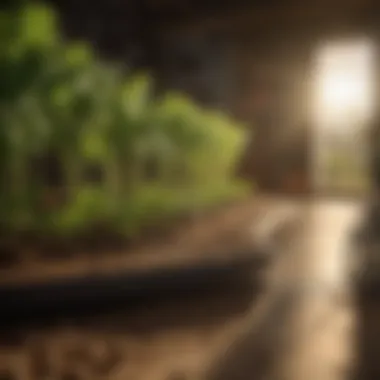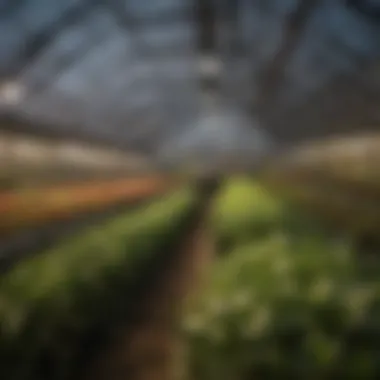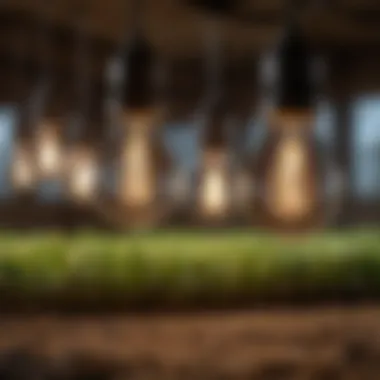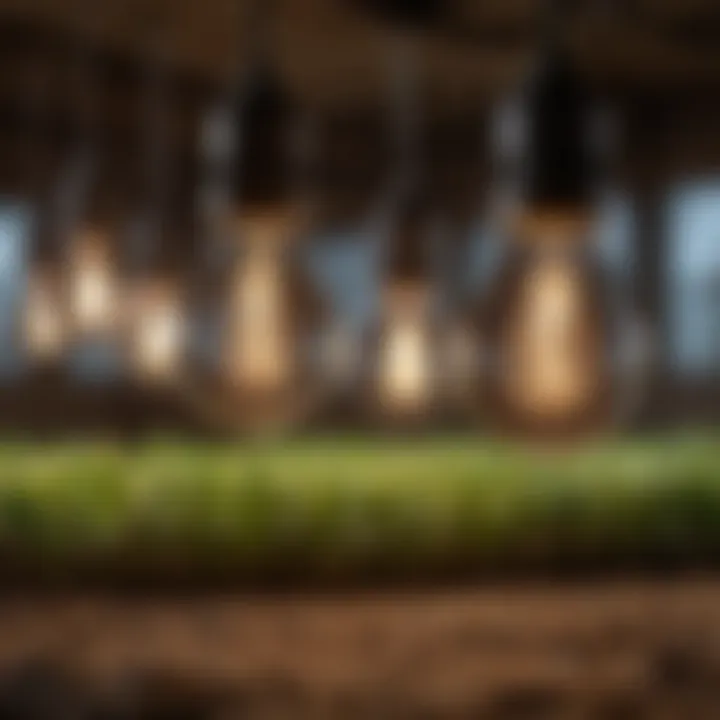Understanding Six-Watt LED Light Bulbs: Efficiency and Applications


Overview of the Topic
Definition and Importance
Six-watt LED light bulbs are becoming increasingly popular in agricultural applications. These bulbs use a relatively low amount of energy while providing high-intensity light. Their role in enhancing plant growth is crucial. They are designed to produce light in specific spectrums that can be beneficial for various stages of plant development. Understanding these bulbs can help farmers optimize their practices and improve yield. Today, energy efficiency is a priority; therefore, utilizing LED technology aligns with sustainable farming goals.
Current Trends
The shift towards more efficient lighting solutions in agriculture is notable. Many farmers are moving away from traditional incandescent or fluorescent bulbs in favor of LED options. This migration is driven by increasing energy costs and the need for lowering carbon footprints. Furthermore, advancements in LED technology offer greater flexibility in terms of light spectrum and control. These trends mark a significant transition in how farmers manage light for crops. Integrating six-watt LED bulbs helps meet both economic and environmental goals.
Key Techniques and Practices
Step-by-Step Guide
- Research Plant Requirements: Understand the specific light needs of the plants you are growing.
- Choose the Right Bulbs: Select six-watt LED bulbs that emit adequate spectrum for your crops.
- Install in Optimal Areas: Position bulbs to evenly distribute light across the growing area.
- Monitor Growth: Observe plant reactions and adjust lighting accordingly.
- Evaluate Energy Use: Keep track of energy consumption to analyze cost-effectiveness.
Tools and Equipment Needed
- Six-watt LED light bulbs
- Light timers for automation
- Light meters to measure intensity
- Dimmers for adjusting brightness
- Proper fixtures to support the bulbs
Challenges and Solutions
Common Obstacles
Farmers may face several challenges when switching to LED technology. One significant issue is the initial investment cost. While LED bulbs last longer and save energy, the upfront expense can be daunting. Another common problem is the learning curve associated with the bulb’s technology. Some growers might struggle with how to effectively manage light intensity and spectrum.
Innovative Solutions
To address the high costs, farmers can look into grants or subsidized programs designed to promote energy-efficient technologies. Additionally, many manufacturers offer incentives for adopting LED lighting. For the learning curve, online resources, workshops, and community forums can provide valuable information. Engaging with other farmers on platforms like Reddit or Facebook can also create a support network, providing encouragement and advice.
"Using six-watt LED light bulbs can significantly improve light efficiency in agricultural settings. This contributes to healthier crops and sustainable practices."
By understanding the efficiency and applications of six-watt LED light bulbs, farmers can make informed decisions that benefit their operations.
Foreword to LED Lighting
The shift towards LED lighting has become a pivotal focus in various sectors, notably agriculture. Understanding LED lighting is essential for grasping how these technologies can optimize growth and improve energy efficiency in farming practices. The significance of this topic is highlighted by the rapid advancement in LED technologies, which offer superior options compared to traditional lighting.
LEDs, or Light Emitting Diodes, are more than just a replacement for older light bulb types. They represent a fundamental innovation that offers numerous benefits. These advantages include lower energy consumption, longer lifespan, and minimal heat production. As farmers and agriculture enthusiasts seek sustainable methods to enhance productivity, LED lighting emerges as a viable alternative. This article will dissect the technical aspects of six-watt LED bulbs, underscoring their efficiency and applications in agriculture.
What is LED Technology?
LED technology involves semiconductors that emit light when an electric current passes through them. This process is known as electroluminescence. Unlike incandescent bulbs, LEDs do not rely on heat to generate light, making them more energy-efficient. The innovation behind LEDs is crucial in addressing the growing demand for more sustainable agricultural practices.
Farmers are increasingly turning to LED technology not only for its energy-saving potential but also for its adaptability to various agricultural needs. The ability to customize color temperature and intensity allows for tailored lighting solutions that enhance plant growth throughout different stages.
Evolution of Light Bulbs
The evolution of light bulbs marks a significant journey towards energy efficiency. The journey began with incandescent bulbs, which produced light by heating a filament. This method resulted in significant energy loss as heat instead of usable light. The advent of fluorescent bulbs in the mid-20th century introduced a more efficient alternative, yet they still had limitations, including lower lifespan and potential environmental hazards due to mercury content.
With the introduction of LED technology in the late 20th century, the scene changed dramatically. LEDs offered a solution that combined long lifespan with reduced energy consumption. As a result, they quickly replaced older lighting options in various applications, particularly in horticulture, where precise light quality is paramount for effective plant growth.
In summary, the emergence of LED bulbs signifies an important milestone in lighting evolution. They provide a pathway towards more sustainable practices and enhanced productivity, particularly in agricultural settings. This is why six-watt LED bulbs warrant particular attention, as they represent an efficient and adaptable option for farmers.
Understanding Six-Watt LED Bulbs


The topic of six-watt LED bulbs is increasingly relevant in today's discussions about sustainable energy use, particularly within agriculture. As our reliance on efficient lighting solutions grows, understanding the specifications and applications of six-watt LED bulbs becomes essential. These bulbs offer a combination of low energy consumption and effective light output, making them suitable for various growing environments, whether indoors or in greenhouses.
The relevance of six-watt LED bulbs lies in their ability to substantially reduce energy costs while providing optimal lighting conditions for plant growth. The efficiency of these bulbs can lead to long-term savings for farmers and horticulturists. Furthermore, they contribute to improved crop yields due to their enhanced spectrum options, which can be tailored for specific growth stages. Consideration of these factors demonstrates the importance of integrating six-watt LED bulbs into modern agricultural practices.
Definition and Specifications
Six-watt LED bulbs are a type of light-emitting diode technology specifically designed to replace traditional incandescent or fluorescent bulbs. They have a power usage of six watts, which translates to a notable decrease in energy consumption. Generally, a six-watt LED bulb can produce light equivalent to a 40-watt incandescent bulb, thus providing greater efficiency.
In terms of specifications, these bulbs typically operate at a voltage range of 120V to 240V, making them compatible with standard electrical systems. They come in various forms, including A-shaped, PAR, and GU10 types, catering to different lighting needs. The efficacy of a six-watt LED bulb often exceeds 80 lumens per watt, ensuring bright lighting with minimal energy use. It is also crucial to consider the Color Rendering Index (CRI), which indicates how accurately a bulb renders colors. A higher CRI value (above 80) is preferable for applications requiring color accuracy, especially in horticulture.
Light Output and Color Temperature
The light output of six-watt LED bulbs varies, but they regularly fall within a range of 400 to 500 lumens. This range makes them suitable for a number of tasks, from general illumination to focused lighting in specific agricultural settings. Selecting the correct light output is vital, as it directly impacts plant growth and development.
Color temperature is another key factor in the efficiency of six-watt LED bulbs. Measured in Kelvin (K), it defines the color appearance of the light. Most six-watt LEDs come in a warm white (around 2700K), neutral white (4000K), or cool white (5000K) spectrum.
- Warm white mimics traditional incandescent light; it is favorable for flowering stages as it promotes a soothing environment.
- Neutral white serves a versatile role and can be used for multiple growth phases.
- Cool white is often utilized for vegetative growth, fostering robust and lush plant structure.
Understanding light output and color temperature is essential for optimizing plant growth and can dramatically affect the efficiency of six-watt LED bulbs in agricultural applications. By tailoring the light characteristics to specific plant needs, growers can enhance crop yields and better manage their energy resources.
Energy Efficiency of Six-Watt LED Bulbs
Energy efficiency is a key focus when discussing six-watt LED bulbs, particularly in agricultural settings. The shift toward energy-efficient lighting solutions is essential for sustainable farming practices. Six-watt LED bulbs present a compelling alternative to traditional lighting options, providing significant advantages in both energy consumption and operational costs.
Comparison with Incandescent Bulbs
When comparing six-watt LED bulbs to incandescent bulbs, the differences in energy consumption stand out. Incandescent bulbs typically convert only about 10% of the energy they use into light. The rest is lost as heat. In contrast, six-watt LED bulbs do not suffer from this inefficiency. They use about 75% less energy than incandescent bulbs while producing the same amount of light. This efficiency translates directly into lower electricity bills and reduced greenhouse gas emissions.
"LED technology has revolutionized how we approach lighting, especially in energy-intensive applications like agriculture."
Benefits of switching to six-watt LEDs include:
- Lower Energy Usage: Significantly less energy consumption per lumen.
- Reduced Heat Production: Less heat means cooler environments, which is crucial for plant health.
- Longevity: LED bulbs can last over 25,000 hours compared to the 1,000 hours of incandescent bulbs.
In specific agricultural contexts, the efficiency of six-watt LED bulbs supports better plant growth while keeping operating costs down. Many farmers are recognizing that replacing traditional lighting with six-watt LEDs could lead to better yields and healthier plants.
Long-Term Cost Savings
In assessing cost savings, the initial investment in six-watt LED bulbs may appear higher than that of traditional bulbs. However, this upfront cost is often offset by the savings on energy bills over time. Here’s a breakdown of the long-term financial benefits:
- Energy Cost Reduction: Using six-watt LEDs can lead to a substantial cut in energy costs due to their efficiency. Estimates suggest farmers could save hundreds of dollars annually, depending on the scale of use.
- Lower Replacement Costs: Given their extended lifespan, six-watt LED bulbs require far less frequent replacement than incandescent bulbs. For farmers, this means less money spent on purchasing new bulbs and labor costs associated with replacements.
- Increased Crop Productivity: Improved lighting can enhance plant health and yields, leading to better market prices and returns. Investing in efficient lighting often results in increased profitability.
Ultimately, the long-term cost savings offered by six-watt LED bulbs make them a wise choice for agricultural applications. As market conditions continue to favor sustainability, adopting energy-efficient practices is not just advantageous; it is becoming a necessity.
Applications in Agriculture and Horticulture
The application of six-watt LED light bulbs in agriculture and horticulture is significant due to their adaptability and efficiency. These bulbs provide optimal light conditions for plants, catering to various growth stages. Understanding these applications aids farmers and growers in making informed choices about lighting solutions.
Indoor Farming and Greenhouses
Indoor farming and greenhouse environments benefit greatly from six-watt LED bulbs. These bulbs offer a tailored light spectrum that encourages photosynthesis, leading to healthier plant growth. They generate minimal heat, allowing growers to maintain stable temperatures to enhance plant health.
Growers utilizing six-watt LED bulbs in indoor farms can control light aspects more flexibly. For instance, they can position bulbs closer to plants compared to traditional bulbs, maximizing light efficiency. This arrangement facilitates better space utilization in compact setups, essential in urban agriculture settings.
"Using LEDs in indoor farming not only promotes better growth, but also contributes to a more sustainable farming model."


Photoperiod Control in Plant Growth
Photoperiod control is crucial in cultivating various plant species. The ability of six-watt LED bulbs to provide specific light durations can trigger certain growth responses in plants. For example, they can be programmed to produce longer light periods during flower initiation for short-day plants.
Farmers can optimize growth cycles by leveraging the programmable features of these lights. Consistent light patterns help to minimize stress that plants may undergo during transitions. This control directly relates to the productivity and yield quality of crops, providing a smart solution for growers.
Seasonal Crop Production
Seasonal crop production significantly benefits from the efficiency of six-watt LED bulbs, particularly when growers want to extend the growing season. These bulbs can simulate summer conditions even in winter months. This extended production timeline meets market demands and provides continuity in supply.
Farmers can adjust the light settings based on seasonal needs, optimizing energy usage while achieving desired growth outcomes. Farms can utilize these bulbs in multiple cycles throughout the year, leading to increased revenue potential while lowering energy costs.
Benefits of Using Six-Watt LED Bulbs
Six-watt LED bulbs offer unique advantages that make them appealing for various users, especially in agriculture. Understanding these benefits is critical for farmers and enthusiasts wishing to enhance their operational efficiency and growth potential. This section focuses on three significant areas where six-watt LED bulbs excel: durability and longevity, reduced heat emission, and improved growing conditions.
Durability and Longevity
One significant advantage of six-watt LED bulbs is their impressive durability. Unlike traditional incandescent bulbs, which have a relatively short lifespan, LED bulbs can last up to 25,000 hours or more. This longevity translates to fewer replacements over time, which is crucial for agricultural settings where consistent lighting is vital for plant health.
- Manufacturing Quality: Many six-watt LED bulbs are made with robust materials that resist breakage, making them ideal for environments that may experience bumps or drops, such as greenhouses or indoor farms.
- Resistance to Elements: They are often designed to endure varying environmental conditions, such as humidity and temperature fluctuations, which can be considerable in agricultural settings.
Overall, the durability and long lifespan of six-watt LED bulbs reduce long-term maintenance costs while ensuring reliable performance in critical stages of plant growth.
Less Heat Emission
Another compelling benefit of six-watt LED bulbs is their low heat output. This characteristic is highly advantageous for agricultural applications, as excess heat can lead to negative impacts on plant growth and crop yield.
- Energy Conversion: Unlike incandescent bulbs, which waste a significant amount of energy in the form of heat, LED bulbs convert approximately 80% of their energy into light, thus minimizing heat release.
- Microclimate Control: Lower heat emission helps maintain optimal temperature conditions in growing areas. This is particularly important in greenhouses or indoor farms where plant climate must be closely monitored.
By reducing heat stress on plants, the six-watt LED bulbs create an environment that promotes better growth and overall health.
Enhanced Growing Conditions
The ability of six-watt LED bulbs to provide optimal light conditions is another significant benefit for agricultural applications. These bulbs can be tailored to emit specific wavelengths of light that are crucial for various stages of plant development.
- Spectrum Customization: Many six-watt LED bulbs are available in different spectrums, allowing farmers to choose lights that best suit their crops. For instance, some plants benefit more from red and blue light during different growth phases.
- Photosynthesis Efficiency: Enhanced light quality directly affects photosynthesis efficiency. The right wavelength encourages plants to absorb light better, supporting faster growth and potentially higher yields.
Key Insight: Using six-watt LED bulbs tailored to plant needs can significantly improve agricultural productivity, making them a valuable investment for growers.
Selecting the Right Six-Watt LED Bulb
Choosing the right six-watt LED bulb is key for maximizing efficiency and benefits in agricultural applications. The rapid growth of LED technology makes it crucial for farmers and enthusiasts to understand how to select the most suitable bulbs. This selection can directly impact the success of indoor farming, greenhouse operations, and even seasonal crop productions.
Farmers must consider multiple factors when picking a six-watt LED bulb. Not only does the choice of bulb influence energy consumption, but it equally shapes the growing conditions for plants. The aim is to provide the right light condition for specific crops while ensuring energy efficiency.
Another important point lies in the adaptability of the bulbs to existing systems or setups. The harmony between the bulbs and the current infrastructure can minimize investment in new systems, saving both time and resources. In essence, a well-thought-out selection leads to enhanced growth and ultimately ensures sustainability in agriculture.
Key Features to Consider
When selecting a six-watt LED bulb, several key features warrant careful attention:
- Light Spectrum: Different crops have unique light spectrum requirements. Knowing if a particular bulb offers the needed red, blue, or full-spectrum light is crucial.
- Lifespan: Look for bulbs with extended lifespans, typically around 25,000 hours or more, to reduce replacement frequency and costs.
- Energy Efficiency: Even within the six-watt range, some bulbs may perform better than others in terms of lumens produced per watt consumed.
- Dimmability: The ability to adjust light intensity can be beneficial for varying plant needs at different growth stages.
- Heat Emission: Since less heat equates to better temperature control, choosing bulbs with lower heat output can help maintain a stable growing environment.
Equipping oneself with knowledge about these features can simplify the decision process and lead to informed choices.


Evaluating Quality and Certification
Evaluating the quality of six-watt LED bulbs is fundamental for durability and effectiveness. Recognizing certification marks can serve as a guideline to determine a product’s quality. Some important certifications include:
- Energy Star: Products bearing this label meet strict energy efficiency guidelines set by the U.S. Environmental Protection Agency.
- UL Certification: Underwriters Laboratories ensure that the bulbs meet safety standards, minimizing fire hazards and electrical failures.
- RoHS Compliance: This ensures that the bulbs are free from hazardous materials, contributing to safer farming practices.
Additionally, checking customer reviews and product ratings can help gauge real-world performance. Some manufacturers offer warranties as a promise of quality. A good warranty often indicates the manufacturer's confidence in their product.
Challenges and Considerations
In the discourse on six-watt LED light bulbs, understanding the challenges and considerations is crucial. While these bulbs offer numerous advantages in energy efficiency and performance, they also present certain challenges that must be acknowledged. Addressing these factors is essential for farmers and horticultural enthusiasts who aim to optimize their use and maximize returns on investment. Identifying potential pitfalls allows for better decision-making in the selection and application of LED lighting.
Initial Investment Costs
One of the most notable challenges regarding the adoption of six-watt LED bulbs lies in their initial investment costs. Generally, the purchase price of LED bulbs can be higher than traditional incandescent or fluorescent bulbs. This price difference can deter farmers from making the switch, especially when budgeting for extensive lighting installations. However, the long-term savings generated by lower energy consumption and longer lifespan can ultimately offset these initial costs.
It is important to consider that the financial outlay for six-watt LEDs can vary based on factors such as brand, design, and added technology features. Investing in higher-quality LED bulbs may result in better light output and efficiency. Therefore, understanding that this upfront expense is, in many ways, a long-term investment is vital.
Compatibility with Existing Systems
Another essential consideration is the compatibility of six-watt LED bulbs with existing lighting systems. Many farms have established lighting setups that may utilize traditional bulbs. Transitioning to LED lighting may require adjustments or even overhauls to current systems. Factors such as dimming capabilities, fixture sizes, and wiring types must all be assessed to ensure a smooth transition.
For instance, some LED bulbs are designed to work with existing dimmers, while others may not function properly or could lead to unexpected results if used in such configurations. Therefore, it is advisable to consult the specifications of potential LED bulbs and evaluate their compatibility with current setups.
Future of LED Technology in Agriculture
The future of LED technology in agriculture holds paramount significance given the evolving demands of food production and sustainability. As farmers and agricultural enthusiasts strive to optimize yields while minimizing environmental impacts, advancements in LED technology offer innovative solutions. The key elements that shape this future include efficiency, flexibility, and integration with smart technologies. Adopting these new technologies can lead to improved growth conditions, energy savings, and enhanced crop quality.
Emerging Trends and Innovations
One notable trend in LED technology is the development of smart lighting systems. These systems can be programmed to adjust light intensity and spectrum based on specific plant requirements. For instance, using different light wavelengths can enhance photosynthesis and promote healthy growth. The Hortimax and Signify companies are at the forefront of creating smart LED solutions tailored for indoor farming.
Another innovation is the incorporation of sensors that monitor plant health, allowing growers to optimize lighting in real-time. These sensors can detect variables like humidity and temperature, and adjust the lighting according to the needs of the plants. In such systems, growers benefit from better resource management and can increase output without proportional increases in energy costs.
"Smart lighting systems represent a transformative approach in agricultural settings, enabling real-time adjustments that enhance plant growth while conserving energy."
The advent of more compact LED fixtures is also worth mentioning. Farmers are now able to install lights in previously inaccessible or small spaces, ensuring that every plant gets adequate light exposure. This trend is crucial for urban farming, where limited space can be a challenge. Furthermore, developments in spectrally tunable LED systems enable farmers to customize light color, thus catering to specific crop needs throughout their growth cycles.
Sustainability Practices in Farming
Adopting six-watt LED bulbs in agriculture contributes significantly to sustainability practices. First, these bulbs consume less power than traditional lighting, thus reducing the carbon footprint. The investment in LED technology pays off not just in lower utility bills, but also in the long-term health of the ecosystem.
Another important aspect is the reduction of heat output from LED lights. Traditional bulbs, such as incandescent lights, release a significant amount of heat, which can stress plants and necessitate cooling systems. In contrast, LEDs maintain stable temperatures, promoting healthier growing conditions.
Additionally, by utilizing LEDs, farmers can extend the growing seasons. With the ability to simulate natural light cycles, crops can thrive year-round, enhancing food production and decreasing reliance on imports. Emphasizing local production aligns with global sustainability goals and food security initiatives.
Moreover, LEDs are designed to last much longer than conventional bulbs, decreasing waste. This longevity translates into fewer replacements and reduced disposal concerns, further supporting eco-friendly practices. Selecting high-quality certified LEDs ensures that the sustainability cycle remains intact, focusing on environmental impact along the entire product lifespan.
Closure
In summarizing the key points regarding six-watt LED light bulbs, it is imperative to recognize the substantial impact these tools can have on agricultural practices. Through their exceptional energy efficiency, they become a formidable alternative to traditional light sources. Understanding their specifications allows farmers to select the right type for their specific needs.
Summary of Key Points
Several essential elements can be summarized:
- Energy Efficiency: Six-watt LED bulbs consume significantly less power while emitting sufficient light for plant growth, which reduces operational costs over time.
- Longevity: These bulbs have a longer lifespan compared to incandescent and even some fluorescent bulbs, which implies less frequent replacements, ultimately benefiting budgets.
- Versatile Applications: From indoor farming setups to greenhouses, the adaptability of six-watt LED bulbs makes them a strategic choice.
- Heat Emission: They generate less heat, which minimizes stress on plants and reduces cooling demands within growing spaces.
"As agricultural practices continue to evolve, the integration of six-watt LED bulbs is becoming less of an option and more of a necessity in ensuring both sustainability and efficiency."
Final Thoughts on Six-Watt LED Bulbs
Ultimately, embracing six-watt LED lighting can create healthier growing environments while also addressing environmental concerns. Knowledge of these bulbs and their applications positions farmers for success in a continually changing agricultural landscape.



